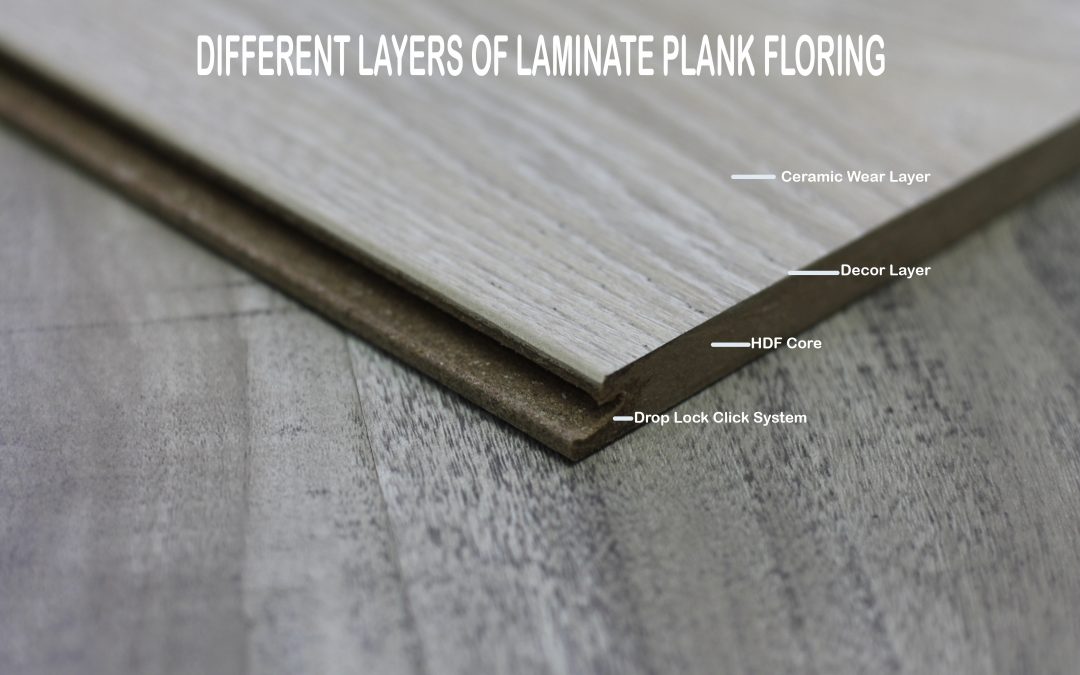Note to the reader:
In this article the technical aspects of laminate flooring will be covered. If you have ever wondered how laminate flooring is made, this article aims to shed light on the intricate process in which laminate flooring is manufactured.
Laminate flooring is comprised of several different layers. These layers are carefully engineered to provide a product which is durable and often cost effective. Laminate flooring has progressed from the original designs, to what is now the cutting-edge product. This article does not intend to convince the reader that laminate flooring is only good floor option available, but instead to enlighten the reader into many of the technical advantages to laminate flooring.
The Different Layers:
As mentioned above, laminate is comprised of several different layers. These layers work together and are designed carefully to maximize stability, rigidity, water resistance, scratch resistance and durability. While there are different laminate products on the market that are made with slight differences, the general concept will apply. This article will provide a base of knowledge that will help the reader understand not only how laminate is made, but how each type of flooring will have its own unique specifications.
Top Coat:
The Top coat of laminate flooring is a clear finish. The top coat layer is made from a mixture of melamine and urethane aluminum oxide. Aluminum oxide finishes are used in many different products and provide a UV cured finish. This finish is resistant to stains and fading from sunlight. The mixture also supports an EIR finish. An EIR finish is what the industry called Register Embossing. This embossing is what provides the realistic texture that follows the pattern of the image on the flooring. The other significant part of the top coat is the melamine, this will help provide stability for the product. The thickness of the top layer is often the same thickness of the bottom layer, and they comprised of similar material.
TL;DR: A textured clear coat finish that protects your floor from stains and sunlight.
Décor Layer:
The Décor layer provides laminate flooring with image that we see. Sourced from high resolution photography, the Décor layer is often designed to look like natural wood. These designs vary from brand to brand and styles change more often that any other part of the laminate plank. Since the design industry is constantly changing, its not uncommon to see brands frequently recycle colors and styles. The décor layer is responsible for tricking the eye into believing that it is looking at authentic hardwood flooring. However, not all laminate flooring is made from photographic images. Some flooring is computer generated and provides other styles for a more niche category of design. Common laminate flooring patterns follow oak and maple flooring.
TL;DR: A photographic printed image, often made to mimic real hardwood flooring.
Core Layer:
The core layer is arguably the most important layer and consists of resin and HDF (High Density Fiber). Some low-quality products have used MDF although this is not recommended. HDF is made from real wood particles and is stabilized with resin. The wood particles are compressed at high pressure and temperature. These particles are made into sheets. Several of these sheets are then compacted together to provide one solid core. The higher-pressure core is made at, the denser and more durable. As the factory’s technology improves, so does the quality of the laminate.
TL;DR: The core is made from HDF. The higher the density of the HDF the better quality the laminate product.
Bottom Layer:
Comprised of similar material as the top coat, the bottom layer provides a stable backing for everything else to be built on. Often it is made to be the same thickness as the top layer to provide the highest level of stability. The bottom layer is made from melamine and provides the consistency for the product to lay flat. Melamine backers are preferred over other backers such as paper backed products.
TL;DR: The bottom layer is made from a melamine compound to provide stability.
Underlayment:
The final layer of laminate flooring is underlayment. This layer is either pre-attached at the factory but is often sold separately. The underlayment is a composite material of varying fibers and filaments. A good choice is EVA (ethylene vinyl acetate) underlayment because of its extremely low impact to the environment and is often a safer choice to eliminate VOCs which often cause health risks. EVA underlayment is also insoluble to water making it added protector from moisture under the floor. The thicker EVA underlayment products are also excellent sound reducers and can reduce the click clack from walking on the floor and provide a reduction in sound transfer between floors.
TL;DR: Underlayment is a required padding layer. It is often pre-attached. Underlayment should never be left out, as it is important to lifespan of your flooring joints. Underlayment can also prevent noise and make your floor less hallow sounding.
End Note:
Laminate flooring is an excellent choice for flooring. Some newer laminate flooring products are water resistant, opening the possibilities of running your floor throughout. This allows for the popular open concept. As with any flooring product, they are not all created equal. This article will help the reader determine quality in a product. With great texture, durability, ease of installation, and thickness; laminate flooring is a great contender as a flooring option for any project.





Recent Comments